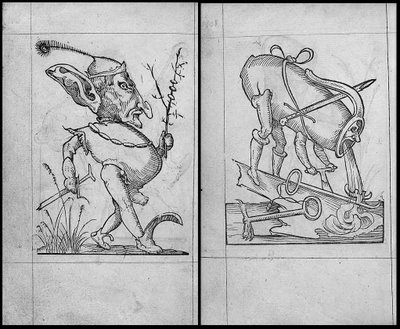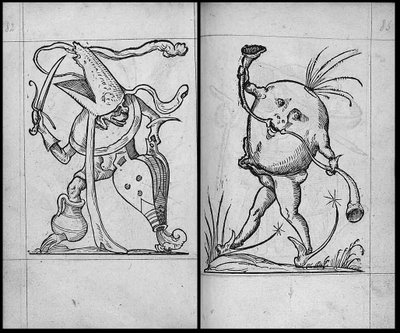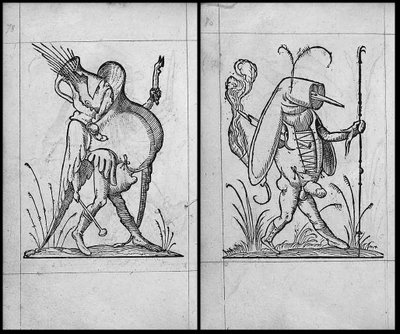"Afterwards I wiped my tail with a hen, with a cock, with a pullet, with a calf's skin, with a hare, with a pigeon, with a cormorant, with an attorney's bag, with a montero, with a coif, with a falconer's lure. But, to conclude, I say and maintain, that of all torcheculs, arsewisps, bumfodders, tail-napkins, bunghole cleansers, and wipe-breeches, there is none in the world comparable to the neck of a goose, that is well downed, if you hold her head betwixt your legs.
And believe me therein upon mine honour, for you will thereby feel in your nockhole a most wonderful pleasure, both in regard of the softness of the said down and of the temporate heat of the goose, which is easily communicated to the bum-gut and the rest the inwards, in so far as to come even to the regions of the heart and brains."
See: Pantagruel I














Franciscan friar, doctor, traveller, model for the Thelemic magickal writings of Aleister Crowley, humanist, Benedictine monk, alchemist, teacher, leader of the French renaissance, heretic, greek scholar and groundbreaking satirical writer, François Rabelais (?1483/1493-1553) issued his magnum opus 'The life of Gargantua and Pantagruel' as a five book series over 20 years up to 1564.
The books chart the humorous adventures of giants Gargantua and his son, Pantagruel in a scatalogical and often bawdy manner. Rabelais wrote in the epic tradition of Homer, and beyond the burlesque, there is an underlying serious examination of society, politics, education and philosophy whilst introducing 500 new words to the french lanugage. It is regarded as one of the great masterpieces of literature.
The images here and in the previous post come from a 1565 publication called 'Les Songes Drolatiques de Pantagruel, ou sont contenues plusieurs figures de l’invention de maistre François Rabelais : & derniere oeuvre d’iceluy, pour la recreation des bons esprits'.
Online translation: 'The drolatic Dreams of Pantagruel, or are contained several figures of the invention of maistre François Rabelais: & derniere work of iceluy, for the recreation of the good spirits.'
It is strongly believed that, although the original publication advertises the series of 120 woodcut grotesqueries as having been drawn by Rabelais himself, it was far likelier that this was a marketing ploy, seeking to capitalize on Rabelais' fame following his death. There is a pitiful amount of information online but the consensus is, partly based on the style of illustration seen in a previous post, Verisimilitude, that these eccentric, surreal and fantastical figures were produced by François Desprez. I even went so far as to go to the local library (first time for everything!) in a futile attempt to seek a bit more information. These absurdist woodcuts are for me the best find of the
That there is any information at all online touching upon Desprez is due in no small part to (no great surprise) Salvador Dali having produed a series of 25 lithographic renderings of Desprez's work which have featured in exhibitions in recent times.
- In total I've posted 52 images between the 2 posts at full size so there are 68 more of these exceptional woodcuts from 'Les Songes Drolatiques de Pantagruel' to be found at Les Bibliothèques Virtuelles Humanistes [LINK UPDATED Aug. 2009].
- This Finnish site has the best biography of Rabelais to my mind.
- Unsurprisingly the Catholic Encylopedia is not a great fan of Rabelais.
- These translated sites review the Dali exhibitions. Also: Dali/Pantagruel at google images.
- The 5 books of 'Gargantua and Pantagruel' (including illustrations by Gustave Doré) are online at Project Gutenburg.
- Renaissance-France.org (in french).
- 'Rabelais: The First Thelemite'.
- 'The Alchemist Monk Francois Rabelais' from 'Green Gold: the Tree of Life, Marijuana in Magic and Religion'.
- The bibliographic notes (in french) from Les Bibliothèques Virtuelles Humanistes are probably the best place to start searching for more information about François Desprez and I think it would need a state/national library. There are many more snippets of information online but unless my searching/scanning ability has deteriorated, there is nothing of particular substance worth linking. This genius deserves more recognition.
- 'Les Songes Drolatiques de Pantagruel' is actually available...for $474.95 at Alibris. Or 26 Swiss Francs at Droz, where there is a short summary (thanks Aitch).
- UPDATE: See this fabulous July 2011 Riowang post on Desprez.
No comments:
Post a Comment